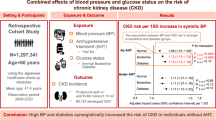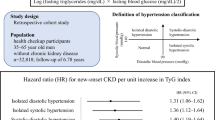Abstract
Metabolic syndrome (MS) has recently been shown to be a forerunner of chronic kidney disease (CKD). Microalbuminuria (MA) is associated with both MS and CKD. This study aimed to prospectively investigate the relationship among MA, MS and renal outcome in non-diabetic patients with primary hypertension. A total of 790 hypertensive patients enrolled in the MAGIC study between 1993 and 1997 (mean age 49.3±10.7 years) were included in the analysis. Renal outcome was defined as the first hospitalization with a diagnosis of CKD. At baseline, 146 (19%) and 60 (7.6%) patients met MS and MA criteria, respectively. A total of 20 patients (2.5%) concomitantly showed MS and MA. After a median follow-up of 11.6 years (interquartile range 3.2 years), renal end point was reached in 15.8% of patients with MS and in 8.9% of those without it (P=0.0087). The incidence of renal events increased progressively starting from patients with neither MS nor MA, to patients with only one of these abnormalities and then to those with both. Significant interaction was observed between MS and MA. Patients with concomitant occurrence of MS and MA at baseline showed a greater than fivefold risk of renal outcome, as compared with patients with neither of these two risk factors (hazard ratio 5.46; 95% confidence interval 2.34–12.75). This risk became even higher when data were adjusted for potential confounders. MS and MA are independent and interactive predictors of renal outcome in non-diabetic patients with primary hypertension.
This is a preview of subscription content, access via your institution
Access options
Subscribe to this journal
Receive 12 digital issues and online access to articles
$119.00 per year
only $9.92 per issue
Buy this article
- Purchase on Springer Link
- Instant access to full article PDF
Prices may be subject to local taxes which are calculated during checkout


Similar content being viewed by others
References
Schieppati A, Remuzzi G . Chronic renal diseases as a public health problem: epidemiology, social, and economic implications. Kidney Int Suppl 2005; 98: S7–S10.
National Kidney Foundation. K/DOQI clinical practice guidelines for chronic kidney disease: evaluation, classification, and stratification. Am J Kidney Dis 2002; 39 (2 Suppl 1): S1–S266.
Ford ES . Risks for all-cause mortality, cardiovascular disease, and diabetes associated with the metabolic syndrome: a summary of the evidence. Diabetes Care 2005; 28: 1769–1778.
Ritz E . Metabolic syndrome and kidney disease. Blood Purif 2008; 26: 59–62.
Ford ES, Giles WH, Mokdad AH . Increasing prevalence of the metabolic syndrome among US adults. Diabetes Care 2004; 27: 2444–2449.
Weir MR . Microalbuminuria and cardiovascular disease. Clin J Am Soc Nephrol 2007; 2: 581–590.
Verhave JC, Gansevoort RT, Hillege HL, Bakker SJ, De Zeeuw D, de Jong PE . An elevated urinary albumin excretion predicts de novo development of renal function impairment in the general population. Kidney Int Suppl 2004; 92: S18–S21.
van der Velde M, Halbesma N, de Charro FT, Bakker SJ, de Zeeuw D, de Jong PE et al. Screening for albuminuria identifies individuals at increased renal risk. J Am Soc Nephrol 2009; 20: 852–862.
Mann JF, Gerstein HC, Yi QL, Lonn EM, Hoogwerf BJ, Rashkow A et al. Development of renal disease in people at high cardiovascular risk: results of the HOPE randomized study. J Am Soc Nephrol 2003; 14: 641–647.
Alberti KG, Zimmet PZ . Definition, diagnosis and classification of diabetes mellitus and its complications. Part 1: diagnosis and classification of diabetes mellitus provisional report of a WHO consultation. Diabet Med 1998; 15: 539–553.
Zavaroni I, Bonini L, Gasparini P, Zuccarelli A, Dall’Aglio E, Barilli L et al. Dissociation between urinary albumin excretion and variables associated with insulin resistance in a healthy population. J Intern Med 1996; 240: 151–156.
Mykkänen L, Zaccaro DJ, Wagenknecht LE, Robbins DC, Gabriel M, Haffner SM . Microalbuminuria is associated with insulin resistance in nondiabetic subjects: the insulin resistance atherosclerosis study. Diabetes 1998; 7: 793–800.
National Cholesterol Education Program (NCEP) Expert Panel on Detection, Evaluation, and Treatment of High Blood Cholesterol in Adults (Adult Treatment Panel III). Third Report of the National Cholesterol Education Program (NCEP) Expert Panel on Detection, Evaluation, and Treatment of High Blood Cholesterol in Adults (Adult Treatment Panel III) final report. Circulation 2002; 106: 3143–3421.
Alberti KG, Zimmet P, Shaw J . The metabolic syndrome: a new worldwide definition. Lancet 2005; 366: 1059–1062.
Grundy SM, Cleeman JI, Daniels SR, Donato KA, Eckel RH, Franklin BA et al. Diagnosis and management of the metabolic syndrome: an American Heart Association/National Heart, Lung, and Blood Institute Scientific Statement [published corrections appear in Circulation 2005; 112:e297 and Circulation 2005;112:e298]. Circulation 2005; 112: 2735–2752.
Pontremoli R, Sofia A, Ravera M, Nicolella C, Viazzi F, Tirotta A et al. Prevalence and clinical correlates of microalbuminuria in essential hypertension: the MAGIC Study. Microalbuminuria: A Genoa Investigation on Complications. Hypertension 1997; 30: 1135–1143.
Andersson T, Alfredsson L, Källberg H, Zdravkovic S, Ahlbom A . Calculating measures of biological interaction. Eur J Epidemiol 2005; 20: 575–579.
Kurella M, Lo JC, Chertow GM . Metabolic syndrome and the risk for chronic kidney disease among nondiabetic adults. J Am Soc Nephrol 2005; 16: 2134–2140.
Kitiyakara C, Yamwong S, Cheepudomwit S, Domrongkitchaiporn S, Unkurapinun N, Pakpeankitvatana V et al. The metabolic syndrome and chronic kidney disease in a Southeast Asian cohort. Kidney Int 2007; 71: 693–700.
Ninomiya T, Kiyohara Y, Kubo M, Yonemoto K, Tanizaki Y, Doi Y et al. Metabolic syndrome and CKD in a general Japanese population: the Hisayama Study. Am J Kidney Dis 2006; 48: 383–391.
Luk AO, So WY, Ma RC, Kong AP, Ozaki R, Ng VS et al. Metabolic syndrome predicts new onset of chronic kidney disease in 5829 patients with type 2 diabetes: a 5-year prospective analysis of the Hong Kong Diabetes Registry. Diabetes Care 2008; 31: 2357–2361.
Palaniappan L, Carnethon M, Fortmann SP . Association between microalbuminuria and the metabolic syndrome: III NHANES. Am J Hypertens 2003; 16: 952–958.
Leoncini G, Ratto E, Viazzi F, Vaccaro V, Parodi D, Parodi A et al. Metabolic syndrome is associated with early signs of organ damage in nondiabetic, hypertensive patients. J Intern Med 2005; 257: 454–460.
Knol MJ, van der Tweel I, Grobbee DE, Numans ME, Geerlings MI . Estimating interaction on an additive scale between continuous determinants in a logistic regression model. Int J Epidemiol 2007; 36: 1111–1118.
Rothman KJ, Greenland S, Walker AM . Concepts of interaction. Am J Epidemiol 1980; 112: 467–470.
Paniagua OA, Bryant MB, Panza JA . Role of endothelial nitric oxide in shear stress-induced vasodilation of human microvasculature: diminished activity in hypertensive and hypercholesterolemic patients. Circulation 2001; 103: 1752–1758.
Stehouwer CD, Lambert J, Donker AJ, van Hinsbergh VW . Endothelial dysfunction and pathogenesis of diabetic angiopathy. Cardiovasc Res 1997; 34: 55–68.
Ryan MC, Fenster Farin HM, Abbasi F, Reaven GM . Comparison of waist circumference versus body mass index in diagnosing metabolic syndrome and identifying apparently healthy subjects at increased risk of cardiovascular disease. Am J Cardiol 2008; 102: 40–46.
Panoulas VF, Ahmad N, Fazal AA, Kassamali RH, Nightingale P, Kitas GD et al. The inter-operator variability in measuring waist circumference and its potential impact on the diagnosis of the metabolic syndrome. Postgrad Med J 2008; 84: 344–347.
Kern EF, Maney M, Miller DR, Tseng CL, Tiwari A, Rajan M et al. Failure of ICD-9-CM codes to identify patients with comorbid chronic kidney disease in diabetes. Health Serv Res 2006; 4: 564–580.
Author information
Authors and Affiliations
Corresponding author
Ethics declarations
Competing interests
The authors declare no conflict of interest.
Rights and permissions
About this article
Cite this article
Leoncini, G., Viazzi, F., Vercelli, M. et al. Metabolic syndrome and microalbuminuria predict renal outcome in non-diabetic patients with primary hypertension: the MAGIC study. J Hum Hypertens 26, 149–156 (2012). https://doi.org/10.1038/jhh.2011.2
Received:
Revised:
Accepted:
Published:
Issue Date:
DOI: https://doi.org/10.1038/jhh.2011.2
Keywords
This article is cited by
-
Comparison between the effects of hydrochlorothiazide and indapamide on the kidney in hypertensive patients inadequately controlled with losartan
Journal of Human Hypertension (2017)



